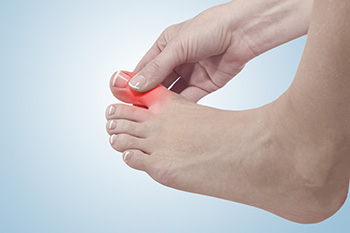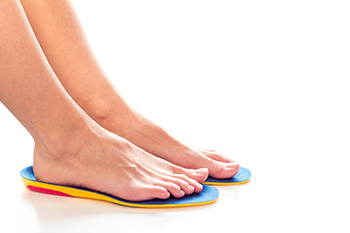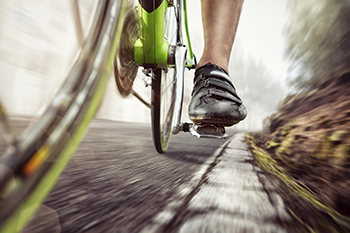Connect With Us
Blog
Items filtered by date: January 2025
Sources of Big Toe Pain

Big toe pain can stem from various conditions, including turf toe and sesamoid fractures, both of which are common in athletes. Turf toe is a sprain of the ligaments surrounding the big toe joint. It is typically caused by hyperextension of the toe during activities like running or football. Symptoms include pain, swelling, and limited movement in the big toe. A sesamoid fracture involves a break in the small bones called sesamoids, under the big toe joint. This injury is often caused by repetitive stress, sudden impact, or wearing improper footwear. Symptoms include localized pain, swelling, bruising, and difficulty bearing weight on the foot. Treatment for both conditions may involve rest, anti-inflammatory medications, and wearing a stiff-soled shoe or brace to limit toe joint movement. In severe cases, a podiatrist may recommend custom orthotics, targeted exercises, or surgery to promote healing. If you have toe pain, it is suggested that you schedule an appointment with a podiatrist.
Toe pain can disrupt your daily activities. If you have any concerns, contact Dr. Eddy Caldwell of Foot Care of Northeast Arkansas, P.A.. Our doctor can provide the care you need to keep you pain-free and on your feet.
What Causes Toe Pain?
Most severe toe pain is caused due to a sports injury, trauma from dropping something heavy on the toe, or bumping into something rigid. Other problems can develop over time for various reasons.
Toe pain can be caused by one or more ailments. The most common include:
- Trauma
- Sports injury
- Wearing shoes that are too tight
- Arthritis
- Gout
- Corns and calluses
- Hammertoe
- Bunions
- Blisters
- Ingrown toenails
- Sprains
- Fractures (broken bones)
- Dislocations
When to See a Podiatrist
- Severe pain
- Persistent pain that lasts more than a week
- Signs of infection
- Continued swelling
- Pain that prevents walking
Diagnosis
In many cases the cause of toe pain is obvious, but in others, a podiatrist may want to use more advanced methods to determine the problem. These can range from simple visual inspections and sensation tests to X-rays and MRI scans. Prior medical history, family medical history, and any recent physical traumatic events will all be taken into consideration for a proper diagnosis.
Treatment
Treatments for toe pain and injuries vary and may include shoe inserts, padding, taping, medicines, injections, and in some cases, surgery. If you believe that you have broken a toe, please see a podiatrist as soon as possible.
If you have any questions please feel free to contact our office located in Jonesboro, AR . We offer the newest diagnostic tools and technology to treat your foot and ankle needs.
Causes and Treatment of Ganglion Cysts

A ganglion cyst is a fluid-filled lump that often forms near tendons or joints in the foot, ankle, or toes. Ganglion cysts are non-cancerous, but they can cause discomfort, pain, or restricted movement depending on their size and location. The exact cause of a ganglion cyst is not always clear but may be linked to repetitive stress, injuries, or irritation of joints and tendons. Symptoms include a visible lump, and pain when applying pressure, tingling, or numbness if the cyst presses on nearby nerves. Diagnosis by a podiatrist usually involves a physical examination and may include imaging tests to rule out other conditions, like bone spurs or plantar warts. Treatment varies based on severity. Some cases may not need intervention, while others that cause significant pain or affect mobility might require aspiration or surgical removal. Aspiration involves draining the fluid, while surgery removes the cyst and its connection to the joint. If you have a ganglion cyst on your foot, it is suggested that you schedule an appointment with a podiatrist for an exam and appropriate treatment.
Foot Pain
Foot pain can be extremely painful and debilitating. If you have a foot pain, consult with Dr. Eddy Caldwell from Foot Care of Northeast Arkansas, P.A.. Our doctor will assess your condition and provide you with quality foot and ankle treatment.
Causes
Foot pain is a very broad condition that could be caused by one or more ailments. The most common include:
- Bunions
- Hammertoes
- Plantar Fasciitis
- Bone Spurs
- Corns
- Tarsal Tunnel Syndrome
- Ingrown Toenails
- Arthritis (such as Gout, Rheumatoid, and Osteoarthritis)
- Flat Feet
- Injury (from stress fractures, broken toe, foot, ankle, Achilles tendon ruptures, and sprains)
- And more
Diagnosis
To figure out the cause of foot pain, podiatrists utilize several different methods. This can range from simple visual inspections and sensation tests to X-rays and MRI scans. Prior medical history, family medical history, and any recent physical traumatic events will all be taken into consideration for a proper diagnosis.
Treatment
Treatment depends upon the cause of the foot pain. Whether it is resting, staying off the foot, or having surgery; podiatrists have a number of treatment options available for foot pain.
If you have any questions, please feel free to contact our office located in Jonesboro, AR . We offer the newest diagnostic and treatment technologies for all your foot care needs.
Custom Orthotics for High Heels

Custom Orthotics help you not have to choose between style and comfort. With Custom Orthotics designed for high heels, you can walk with confidence, knowing your feet are supported. Custom Orthotics help distribute pressure evenly, reducing the risk of pain and discomfort. Whether it's a day at the office or a night on the town, make every step graceful and pain-free. Discover the magic of Custom Orthotics for high heels by calling our office today.
Nerve Pain on the Top of the Foot

Nerve pain on the top of the foot is often caused by pressure or irritation from tight shoes or laces. This pressure can compress nerves, leading to pain, numbness, or tingling that may spread to the toes. Activities that involve repetitive movement, such as running or dancing, can worsen the problem, especially when combined with foot mechanics or wearing improper footwear. Bony growths or inflammation can also contribute to nerve pain on top of the foot, also referred to as vamp disease, by pressing against nearby tissues. A podiatrist can identify the root cause of this discomfort through a detailed examination and imaging, if needed. Treatments focus on relieving pressure on the nerves, which may include changes in footwear or adjustments to how shoes are laced. For more persistent cases, it is suggested that you contact a podiatrist who may recommend surgery to remove bony growths or reduce nerve compression.
Neuropathy
Neuropathy can be a potentially serious condition, especially if it is left undiagnosed. If you have any concerns that you may be experiencing nerve loss in your feet, consult with Dr. Eddy Caldwell from Foot Care of Northeast Arkansas, P.A.. Our doctor will assess your condition and provide you with quality foot and ankle treatment for neuropathy.
What Is Neuropathy?
Neuropathy is a condition that leads to damage to the nerves in the body. Peripheral neuropathy, or neuropathy that affects your peripheral nervous system, usually occurs in the feet. Neuropathy can be triggered by a number of different causes. Such causes include diabetes, infections, cancers, disorders, and toxic substances.
Symptoms of Neuropathy Include:
- Numbness
- Sensation loss
- Prickling and tingling sensations
- Throbbing, freezing, burning pains
- Muscle weakness
Those with diabetes are at serious risk due to being unable to feel an ulcer on their feet. Diabetics usually also suffer from poor blood circulation. This can lead to the wound not healing, infections occurring, and the limb may have to be amputated.
Treatment
To treat neuropathy in the foot, podiatrists will first diagnose the cause of the neuropathy. Figuring out the underlying cause of the neuropathy will allow the podiatrist to prescribe the best treatment, whether it be caused by diabetes, toxic substance exposure, infection, etc. If the nerve has not died, then it’s possible that sensation may be able to return to the foot.
Pain medication may be issued for pain. Electrical nerve stimulation can be used to stimulate nerves. If the neuropathy is caused from pressure on the nerves, then surgery may be necessary.
If you have any questions, please feel free to contact our office located in Jonesboro, AR . We offer the newest diagnostic and treatment technologies for all your foot care needs.
Let the Expert Treat Your Ingrown Toenails
Customized Foot Orthotics and Achilles Tendinopathy

Achilles tendinopathy is characterized by pain and inflammation in the Achilles tendon. By cushioning the foot and redistributing pressure, orthotics reduce strain on the Achilles tendon alleviating pain and preventing further damage. Orthotics can also help correct abnormal gait patterns like pronation, which can contribute to the development or worsening of Achilles tendinopathy. Custom orthotics are designed to fit the unique contours of an individual’s foot, ensuring that the heel and arch are properly supported, thereby reducing the load on the tendon. Regularly using orthotics can improve foot mechanics, enhance mobility, and speed up recovery, allowing individuals to return to normal activities with less discomfort. If you have this condition, it is suggested that you consult a podiatrist who can guide you toward custom-made orthotics for relief and treatment.
If you are experiencing discomfort in your feet and would like to try custom orthotics, contact Dr. Eddy Caldwell from Foot Care of Northeast Arkansas, P.A.. Our doctor can provide the care you need to keep you pain-free and on your feet.
What Are Custom Orthotics?
Custom orthotics are inserts you can place into your shoes to help with a variety of foot problems such as flat feet or foot pain. Orthotics provide relief and comfort for minor foot and heel pain.
Over-the-Counter Inserts
Shoe inserts come in a wide variety and are used to treat foot pain, heel pain, and minor problems. For example, arch supports can be inserted into your shoes to help correct overarched or flat feet, while gel insoles are often used because they provide comfort and relief from foot and heel pain by alleviating pressure.
Prescription Orthotics
If over-the-counter inserts don’t work for you or if you have a more severe foot concern, it is possible to have your podiatrist prescribe custom orthotics. These high-quality, custom inserts are designed to treat problems such as abnormal motion, plantar fasciitis, and severe forms of heel pain. They can even be used to help patients suffering from diabetes by treating foot ulcers and painful calluses and are usually molded to your feet individually, which allows them to provide full support and comfort.
If you're experiencing minor to severe foot or heel pain, it’s recommended to speak with your podiatrist about the possibility of using custom orthotics or shoe inserts. A podiatrist can determine which type of custom orthotic or shoe insert is right for you and help you take the first steps toward being pain-free.
If you have any questions please contact our office located in Jonesboro, AR . We offer the newest diagnostic and treatment technologies for all your foot and ankle needs.
How the Foot Bones Work Together During Cycling

While cycling, the bones in the foot work together to provide stability, power, and efficient movement. The foot’s arch supports the weight of the body and helps absorb shock with each pedal stroke. The bones in the foot, including the tarsals, metatarsals, and phalanges, form a flexible structure that adapts to the pressure of pedaling. The first metatarsal bone plays a vital role in pushing down on the pedal, while the other metatarsals work together to distribute force evenly. The bones in the foot, along with the muscles and tendons, maintain balance and ensure a smooth, effective pedal stroke. Proper cycling shoes are essential for supporting the foot’s bones, preventing unnecessary stress, and improving performance. If you have sustained a foot injury while cycling, it is suggested that you consult a podiatrist who can offer effective relief and treatment solutions.
If you have any concerns about your feet, contact Dr. Eddy Caldwell from Foot Care of Northeast Arkansas, P.A.. Our doctor can provide the care you need to keep you pain-free and on your feet.
Biomechanics in Podiatry
Podiatric biomechanics is a particular sector of specialty podiatry with licensed practitioners who are trained to diagnose and treat conditions affecting the foot, ankle and lower leg. Biomechanics deals with the forces that act against the body, causing an interference with the biological structures. It focuses on the movement of the ankle, the foot and the forces that interact with them.
A History of Biomechanics
- Biomechanics dates back to the BC era in Egypt where evidence of professional foot care has been recorded.
- In 1974, biomechanics gained a higher profile from the studies of Merton Root, who claimed that by changing or controlling the forces between the ankle and the foot, corrections or conditions could be implemented to gain strength and coordination in the area.
Modern technological improvements are based on past theories and therapeutic processes that provide a better understanding of podiatric concepts for biomechanics. Computers can provide accurate information about the forces and patterns of the feet and lower legs.
Understanding biomechanics of the feet can help improve and eliminate pain, stopping further stress to the foot.
If you have any questions please feel free to contact our office located in Jonesboro, AR . We offer the newest diagnostic and treatment technologies for all your foot and ankle needs.






